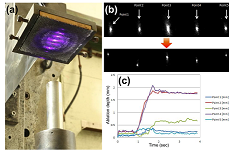
Juhwan Lim
Agency for Defense Development, South Korea
Title: In-situ measurement for ablation geometry during impinging of plume with laser triangulation method
Biography
Biography: Juhwan Lim
Abstract
In-situ ablation measurement of glass phenolic (G/P) composite during hot plume impinging was studied using laser triangular method. G/P, a representative anti-ablative material has been studied for its application in aerospace, automobile, and defense area. Especially, the ablation mechanism by aerodynamic heating has been well studied with various measurement methods for developing accurate computational model. However, when G/P is required to resist impinging plume, such as plume resistance plate in vertical launching system, different ablation behavior exhibits which demands another investigations for this mechanism and computational model. Therefore, in-situ measurement method for proving mechanism and developing computation model of ablation with impinging plume of high pressure and temperature is highly required. The G/P composite, a suitable material for resisting impinging plume from rocket nozzle, was tested its ablative characteristic using small-scaled booster with 16% concentration of alumina particle. The plume impinged vertically to material surface with about two seconds. During the test, real-time measurement of ablation geometry was conducted with laser triangular method, using laser wavelength of 405 nm and laser intensity of 0.44 W. The laser spots were spread on material surface by diffractive optical elements, and monitored using high-speed camera. The laser signal was distinguishable even in the atmosphere of existing hot plume by installing optical filter, and the movement of laser spots during the test was monitored and calculated to ablation rate. The transient section of combustion and radiation of hot plume occasionally shaded the laser, while the highest precision level of real-time recession measurement confirmed. Moreover, the high accuracy of this method has been proved via comparing with thermocouple signal and geometry scanning after the test. We believe this method, which firstly conducted with highest accuracy and stability, showed its high potential for broaden research of anti-ablative materials.



